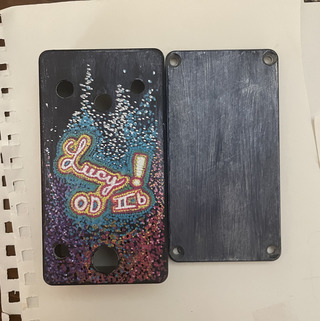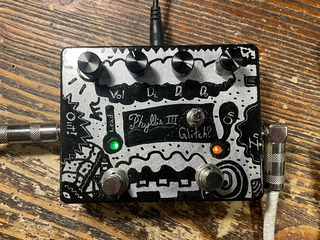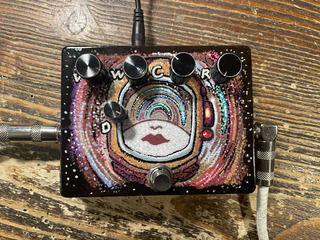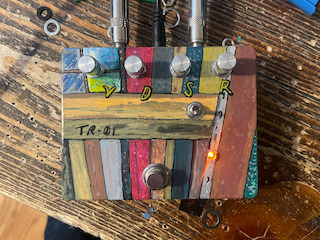Coming soon
- Video/audio demos
- Blurbs for additional units
- Free schematics for a subset of units (elsewhere, but I’ll link them here)
Background
I started building effects units in 2017. I started studying electronics theory in earnest, shortly thereafter, and have been designing my own analog, digital, and mixed-mode electronics since.
Though, the effects I design are really designed with my own needs/preferences in mind, I tend to build in more than a little flexibility. As a result, they’ve enjoyed wider usage than anticipated. I’ve started doing them in runs on occasion — selling or gifting the extra units.
I’m a one-man design/build shop and do this for fun, so when I say “production run”, it means “professionally fabricated PCB’s, produced in batches of five to fifteen.”
So far: people dig ‘em!
Construction
Prototypes are typically built on perfboard or FR4 and handwired. Occasionally, I home-etch a PCB or two.
I design PCB’s for the production units and have them professionally fabricated. The components are predominantly hand-soldered, through-hole mount — I like to keep them hacker/mod/repair friendly, whenever possible.
The enclosures are drilled and painted by hand. For the most part, the artwork is acrylic on aluminum with a few generous coats of high-gloss clear coat (the kind you’d use on a car or machine chassis). They are very durable.
Each model has a general style/theme that I adhere to, but there is (sometimes considerable) variation from one unit to the next. I like it that way. Each pedal is a unique work of “art” (I’m not a skilled artist; I’m a prolific and lazy doodler). It’s not very efficient (it’s two coats per dot on the pointalism ones!), but I do this for joy not profit.
The Units
I’ve been through hundreds of designs (naturally, many — very many — were duds, especially in the beginning). Some have been one-offs or custom designs for a friend or customer (some of those are due to have production runs of their own).
The following are the units that have had at least one production run (the docs
for some are still TODO items):
- Lucy Overdrive — Spacesuit
- Lucy Overdrive — Mars Red
- Lucy Overdrive II
- Phyllis III Multi-Octave Synth Fuzz
- SR-03 Phaser
- Manwë Chorus
- P-38 / P-38-R
- TR-01 Tremolo
- Syndicated Drive
- “Yup!” and “Okay!” mini “grit” pedals
- My personal four-in-one combo dirt unit
- The Revibe (Univibe-ish phaser)
- Old Radio
- The Walkie-Screamie
Phyllis III Multi-Octave Synth Fuzz
I designed this pedal to allow me to recreate the synth tone from an old song of mine on the guitar. It derives five different signals from the input — an overdrive, two square wave fuzzes with slightly different duty cycles and frequency responses, and one and two octaves down. The output stage is a mixer with some frequency-dependent gating that adds some permutation of four of the five channels.
It has a “glitch” mode that pits the two square-fuzzes against each other to drive the suboctaves. In glitch mode, the attack and harmonics influence which of the two fuzz signals gets through the gate. The result is some lovely glitchy breakup that dances between the fundamental and even harmonics thereof as you play.
Each of the derived signals is filtered differently on the way out, shaving off some of the harsh higher-order harmonics. This provides a rich, bassy, synth tone without a lot of “tin.”
It’s a lot of fun.
The artwork on each was made by covering the enclosure in black caligraphy ink, waiting for it to set, and scratching out doodles and control labels using a small screwdriver.
SR-03 Phaser
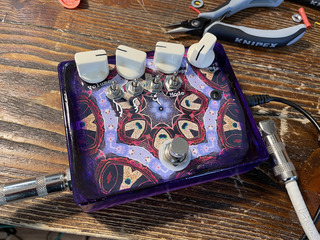
This is a six-stage phaser, arranged in three pairs of phase shifters, with a frequency toggle for each — providing eight total modulation patterns. One of the eight permutations provides neat approximtions of an MXR Phase 90-like classic phaser; another provides a nice, liquidy, univibe-type modulation.
There is no LFO, no LDR’s, LED’s, or lightbulbs. There are no JFET’s. I don’t have any OTA’s to play with!
The circuit is built around CMOS transmission gates that are switched at supersonic frequencies to modulate the transfer curve of sets of all-pass filters. This is a “digitally-controlled analog” pedal: the signal path is all analog, but the modulation is controlled by a digital clock and counter.
There is one toggle switch for each of three phase shifting pairs, a “center” control that sets the modulation midpoint, a range control which controls the magnitude of the shift from center, and a rate control that adjusts the speed at which the modulation varies.
Bonus: in addition to the standard periodic shift pattern, it also also has a random mode. When random is engaged, the range and center controls are used as inputs to a psuedo-random hash functiion that causes the modulation to jump sharply from one frequency band to another at irregular intervals. At slower speeds this almost sounds like an arpeggiator, due to the alternating prominence of different harmonics. At fast speeds, it sounds like your guitar is submerged in a bubbling lake.
(The board also facilitates MIDI/expression control, but I didn’t put any external jacks on the units from the initial run).
The art for these is acryllic on aluminum — though the one featured above is the original prototype, which sports an inkjet graphic that is haphazardly affixed to the face of the unit.
Manwë Chorus
This is chorus pedal designed around the MN3208 BBD. I think it’s a lot of fun, owing to the wide variety of sounds you can get out of it.
It has five controls:
- Volume
- Wobble: controls the magnitude of the wet signal’s delay — i.e. how far ahead and behind of the delay center point the delayed signal will swing.
- Center: this is a four-stop rotary toggle that controls the center point of the delay. On the small end, the delay midpoint is in flanger territory — 10-20 milliseconds. On the large end, the delay midpoint is on the long-end of a “chorus” delay, approaching the timing of a slapback reverb. The two middle settings yield more classic chorus timings, allowing tidy approximations of a fairly wide range of classic chorus pedals.
- Rate: is your standard LFO speed control
- Depth: is a wet/dry mix control. On the low end, the chorus effect can be made very sublte, fattening up the guitar tone without much in the way of perceivable modulation. On the high end, the wet signal is actually about 3dB louder than the dry, facilitating a vibrato sound that can span the gamut from “church organ” to “seasick pitch wobbling” (if you’ve ever played the old SNES game, Earthbound, you’ll get the gist).
The art on each is a variation of the artwork I did for the “Lucy Spacesuit”1 editions of my overdrive pedal. It’s acryllic paint — variously applied with a fine-tipped brush or else using paint pens.
P-38
This pedal uses the basic Big Muff topology for the gain and clipping stages — with some caveats: the clipping stages are more heavily frequency dependent, the range and symmetry of frequencies clipped is adjustable via a three way toggle; rather than being an HPF/LPF mix control, the tone knob adjusts the phase rotation and relative weight of two copies of the signal — yielding usable tones across the full range of the control, at the expense of less extreme extremes.
It doesn’t facilitate “muffled” lows or “sack of razorblades and tin” highs (I’m not knocking those, either! Sometimes, those are exactly what you want! I get it!). It is designed to produce a fairly wide range of distortion tones that range from “fat” to “cutting.”
The natural tone of the guitar can shine through or be compressed out almost entirely, depending on the gain setting. The clipping stages have a higher LPF cutoff than is typical of Muffs and Muff clones. This allows for some really gnarly pinch harmonics, but is still low enough to prevent the screaming, high-frequency, feedback when nothing is being played.
I think it sounds pretty great.
The artwork on these units are “sky and clouds” backdrops — each of which is inspired by a different photo from an evergrowing collection of sky photos I’ve taken in and around the Hudson Valley.
TR-01 Tremolo
This is a tremolo. It’s not super fancy, but it does what I like. Controls are
- V: Volume
- D: Depth
- S: Shape (triangular/ocean-wave counterclockwise; sine wave clockwise)
- R: Rate
The toggle controls whether the tremolo takes the whole signal up and down or just a selection of mid and high frequencies. I use this mode for gentle chord passages — the lower notes remain mostly unchanged, while higher notes have their volume modulated in proportion to frequency. It gives a “shimmery” kind of a sound that I dig (it can almost sound like two guitars).
Syndicated Drive
This tarted as a fulltone OCD clone. The transfer curves for the gain and clipping stages are altered to be a little less bottom heavy. The clipping transfer curve is more frequency dependent. The tone control is dual-gang and modifies the clipping response as well as the post-clipping filter in tandem.
“Yup!” and “Okay!” Mini Grits
These are simple two-transistor boost pedals. The “Yup!” has feedback clipping while the Okay is biased such that the transistors go into saturation a little earlier than the yup.
They’re utility pedals, but I dig ‘em!
Four-in-One
This is my four favorite dirt pedals in one box.
Left to right:
- The “Yup!” mini grit
- “Lucy Overdrive”: my first ever overdrive pedal)
- “Syndicated Overdrive”
- The P-38
I only ever use two of these at a time, so preferred to toggles + two stomp switches to four stomp switches (which I’ve done elsewhere; here, familiarity — I usually have some kind of grit and a boost == two stomp switches — was a big design factor).
Revibe
This is a Univibe-like phaser, with some adjustment to the phase notches.
Just has a rate and depth knob. Volume in is volume out. Simple to use and (I think) it sounds great.
The Old Radio
Inspired by the Fulltone OCD I decided to noodle with MOSFETs as clipping elements. I was playing around with the sound of just barely hitting enough signal to start making the clipping noticeable and ended up digging it enough to slap it in a case.
Some of my “for me” builds don’t have labels (I think it’s kind of funny). This one is volume on the left, tone on the right. There is no gain control. That’s kind of an odd move, but there’s something a little fun about a thing that really only does one thing. When it’s in rotation: I know what I’m getting!
WalkieScreamie
This is a PLL-based autowah fuzz. I would tell you what the controls are, but…I don’t know what to call them. They all modify parameters for the loop controller on the PLL.
The PLL loop controller is configured to have a little lag and for that lag to be asymmetrical. Sounds like an old video game through a big speaker.
More on the way…
Have a lot of undocumented builds and a lot of builds queue’d.
More updates when time allows!
-
Among the pedals not yet documented here. ↩
